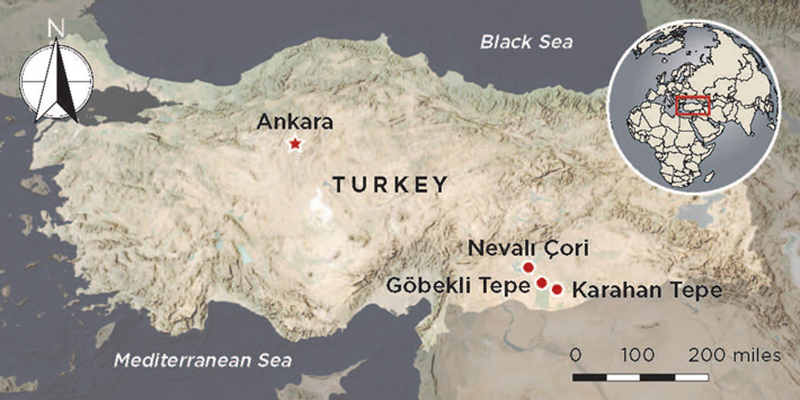

As we uncover evidence of ancient cultures - we are continually confronted with the idea that the timeline of human history is not as linear or straightforward as we might have believed.
With each discovery, the narrative of human evolution, migration, and societal development becomes richer and more complex. This ongoing process raises fundamental questions about our identity and the nature of reality.
With every discovery believed to be the oldest ever unearthed - along comes another in some ancient part of the world to upend it. Gobekli Tepe was one of those markers that reset the chronological timeline to 12,000 years ago give or take.
August 2025 - Currently, in northern Jordan, we find Wadi Hammeh 27 a Late Epipalaeolithic archaeological site that consists of the remains of a large settlement dating to 14,000 - 4,500 years ago.
Let's go back to the beginning if indeed there was one ...
In the age of artificial intelligence, we are realizing the possibility that we exist in a simulation. Reality is a never-ending quest to understand that concept while looking to the past - then integrated information found with current discoveries to create a compilation of facts in the narrative of the human journey.
Each discovery is an insert in the simulation that propels humans to continue the quest no matter what the obstacles. It's as if humans exist in a classroom using available tools to figure out eternal questions. Today those tools include artificial intelligence linked to our very creation and existence.
As humans keep "digging" for answers - hopefully information buried for all time will be shown in their final hour.
Did ancient aliens build the structures that are currently being excavated at Gobekli Tepe, Turkey which date back approximately 12,000 years? Some people believe this to be true, while others are discovering answers of how primitive people worked together to create Gobekli Tepe as a place to live and worship.
On August 6, 2025 explorer, archeologist and Discovery Channel presenter Josh Gates traveled to Turkey to explore the ancient ruins of Gobekli Tepe and nearby Karahan Tepe in an episode called Expedition Unknown - Mystery Ruins of the Stone Age". There he met with fellow archaeologists about their updated findings - adding a twist of humor at the mention of ancient aliens. If there was further discussion along alien lines - it was obviously edited out.
While keeping an open mind - Josh never actually stated how he thought the sites were created - and why they were later buried - but I got the feeling he connects them in some way to ancient alien theory - which archaeologists dispute. Pics and Videos on Facebook

There Josh and other archaeologists examined Neolithic settlements that date back at least 12,000 years, potentially making them the world's oldest known megalithic structures. Though the topic of ancient aliens creating these ruins was briefly discussed - archaeologists explained their creation by early humans.



Tour guide Sabahattin Alkan herds curious tourists through the scorching afternoon heat, luring them with the promise of something far stranger than your typical vacation snap. "Over here on the right, you see a spaceship landed recently," he says with a grin. He's joking. Mostly. But more on that in a minute. We're in the Urfa plain, a dry, dusty stretch about 25 miles from the Turkish-Syrian border. That "spaceship" is actually just a curved roof. But what lies beneath the dome has sparked decades of mystery, curiosity - and conspiracy.
Gobekli Tepe (Turkish for "Hill with a potbelly") is a hilltop sanctuary erected on the highest point of an elongated mountain ridge some 15 km northeast of the town of Sanliurfa (formerly Urfa / Edessa) in southeastern Turkey.
The site, currently undergoing excavation by German and Turkish archaeologists, was erected by hunter-gatherers in the 10th millennium BC (ca. 11,500 years ago), before the advent of sedentism. Mysteriously, the entire complex of stones, pillars and carvings was then deliberately buried in 8000 BC. Together with Nevalõ Cori, it has revolutionized understanding of the Eurasian Neolithic.
Gobekli Tepe is located in southeastern Turkey. It had already been noted in an American survey in 1964, which recognized that the hill could not entirely be a natural feature, but assumed that a Byzantine cemetery lay beneath.

Since 1994 excavations have been conducted by the German Archaeological Institute (Istanbul branch) and Sanliurfa Museum, under the direction of the German archaeologist Klaus Schmidt (1995-2000: University of Heidelberg; since 2001: German Archaeological Institute). Schmidt says that the stone fragments on the surface made him aware immediately that the site was prehistoric.
Before then, the hill had been under agricultural cultivation; generations of local inhabitants had frequently moved rocks and placed them in clearance piles; much archaeological evidence may have been destroyed in the process. Scholars from the Hochschule Karlsruhe began documenting the architectural remains. They soon discovered T-shaped pillars, some of which had apparently undergone attempts at smashing.

Gobekli Tepe is perhaps the oldest human-made place of worship yet discovered. Until excavations began, a complex on this scale was not thought possible for a community so ancient.
The massive sequence of stratification layers suggests several millennia of activity, perhaps reaching back to the Mesolithic.
The oldest occupation layer (stratum III) contains monolithic pillars linked by coarsely built walls to form circular or oval structures. So far, four such buildings, with diameters between 10 and 30m have been uncovered. Geophysical surveys indicate the existence of 16 additional structures.
Stratum II, dated to Pre-Pottery Neolithic B (PPNB) (7500-6000 BC), has revealed several adjacent rectangular rooms with floors of polished lime, reminiscent of Roman terrazzo floors. The most recent layer consists of sediment deposited as the result of agricultural activity.
The monoliths are decorated with carved reliefs of animals and of abstract pictograms. The pictograms cannot be classed as writing, but may represent commonly understood sacred symbols, as known from Neolithic cave paintings elsewhere.


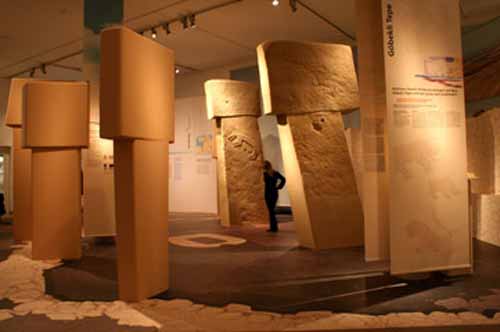
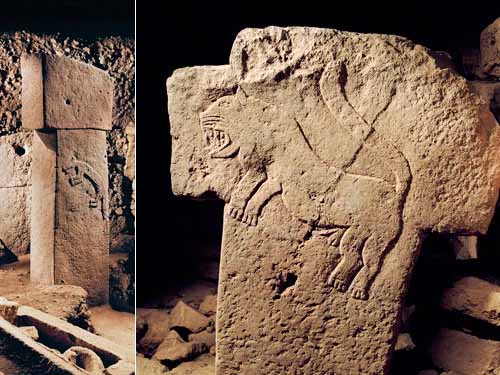
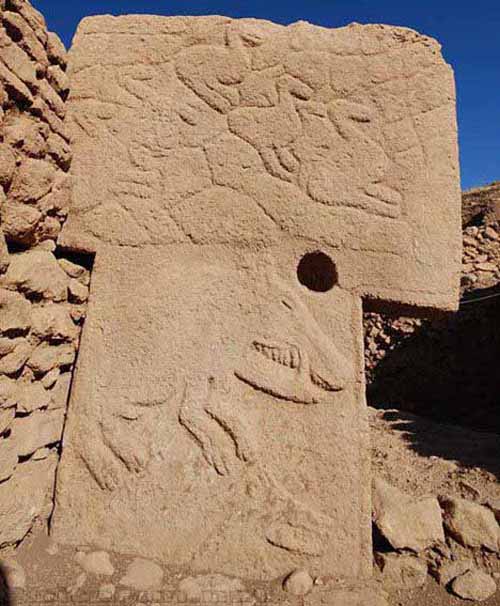
The carefully carved figurative reliefs depict lions, bulls, boars, foxes, gazelles, asses, snakes and other reptiles, insects, arachnids, and birds, particularly vultures and water fowl. At the time the shrine was constructed the surrounding country was much lusher and capable of sustaining this variety of wildlife, before millennia of settlement and cultivation resulted in the near-Dust Bowl conditions prevailing today.
Vultures also feature in the iconography of the Neolithic sites of Catalhoyuk and Jericho; it is believed that in the early Neolithic culture of Anatolia and the Near East the deceased were deliberately exposed in order to be reincarnated by vultures and other birds of prey. (The head of the deceased was sometimes removed and preserved - possibly a sign of ancestor worship.) This, then, would represent an early form of sky burial.
Few humanoid forms have surfaced at Gobekli Tepe but include a relief of a naked woman, posed frontally in a crouched position, that Schmidt likens to the Venus accueillante figures found in Neolithic north Africa; and of at least one decapitated corpse surrounded by vultures. Some of the pillars, namely the T-shaped ones, have carved arms, which may indicate that they represent stylized humans (or anthropomorphic gods). Another example is decorated with human hands in what could be interpreted as a prayer gesture, with a simple stole or surplice engraved above; this may be intended to represent a temple priest.
The houses or temples are round megalithic buildings. The walls are made of unworked dry stone and include numerous T-shaped monolithic pillars of limestone that are up to 3 m high. Another, bigger pair of pillars is placed in the centre of the structures. There is evidence that the structures were roofed; the central pair of pillars may have supported the roof. The floors are made of terrazzo (burnt lime), and there is a low bench running along the whole of the exterior wall.
The reliefs on the pillars include foxes, lions, cattle, wild boars, wild asses, herons, ducks, scorpions, ants, spiders, many snakes, and a very few anthropomorphic figures. Some of the reliefs have been deliberately erased, maybe in preparation for new designs. There are freestanding sculptures as well that may represent wild boars or foxes. As they are heavily encrusted with lime, it is sometimes difficult to tell. Comparable statues have been discovered at Nevali Cori and Nahal Hemar.
The quarries for the statues are located on the plateau itself; some unfinished pillars have been found there in situ. The biggest unfinished pillar is still 6.9 m long; a length of 9m has been reconstructed. This is much larger than any of the finished pillars found so far. The stone was quarried with stone picks. Bowl-like depressions in the limestone rocks may already have served as mortars or fire-starting bowls in the epipalaeolithic. There are some phalloi and geometric patterns cut into the rock as well; their dating is uncertain.
While the structures are primarily temples, more recently smaller domestic buildings have been uncovered. Despite this, it is clear that the primary use of the site was cultic and not domestic. Schmidt believes this "cathedral on a hill" was a pilgrimage destination attracting worshipers up to a hundred miles distant. Butchered bones found in large numbers from local game such as deer, gazelle, pigs, and geese suggest that ritual feasting (and perhaps sacrifice) were regularly practiced here.
The site was deliberately backfilled sometime after 8000 BC: the buildings are covered with settlement refuse that must have been brought from elsewhere. These deposits include flint tools like scrapers and arrowheads and animal bones. The lithic inventory is characterized by Byblos points and numerous Nemrik-points. There are Helwan-points and Aswad-points as well.
All statements about the site must be considered preliminary, as only about 5% of the site's total area has been excavated as yet; floor levels have been reached in only the second complex (complex B), which also contained a terrazzo-like floor. Schmidt believes that the dig could well continue for another fifty years. So far excavations have revealed very little evidence for residential use. Through the radiocarbon method, the end of stratum III can be fixed at circa 9,000 BC (see above); its beginnings are estimated to 11,000 BC or earlier. Stratum II dates to about 8,000 BC.
Archaeologist Ofer Ben-Yosef of Harvard has said he would not be surprised if evidence surfaces proving slave labor was involved which would also represent something of a first, since hunting-gathering communities are traditionally thought to have been egalitarian and to predate slavery. At any rate, it is generally believed that an elite class of religious leaders supervised the work and later controlled whatever ceremonies took place here. If so, this would be the oldest known evidence for a priestly caste - much earlier than such social distinctions developed elsewhere in the Near East.
Around the beginning of the 8th millennium BC "Potbelly Hill" lost its importance. The advent of agriculture and animal husbandry brought new realities to human life in the area, and the "stone-age zoo" (as Schmidt calls it) depicted on the pillars apparently lost whatever significance it had had for the region's older, foraging, communities. But the complex was not simply abandoned and forgotten, to be gradually destroyed by the elements. Instead, it was deliberately buried under 300 to 500 cubic metres of soil. Why this was done is unknown, but it preserved the monuments for posterity.
Gobekli Tepe is regarded as an archaeological discovery of the greatest importance, since it profoundly changes our understanding of a crucial stage in the development of human societies. It seems that the erection of monumental complexes was within the capacities of hunter-gatherers and not only of sedentary farming communities as had been previously assumed. In other words, as excavator Klaus Schmidt put it: "First came the temple, then the city." This revolutionary hypothesis will have to be supported or modified by future research.
Schmidt considers Gobekli Tepe a central location for a cult of the dead. He suggests that the carved animals are there to protect the dead. Though no tombs or graves have been found so far, Schmidt believes they remain to be discovered beneath the sacred circles' floors.
Schmidt also interprets it in connection with the initial stages of an incipient Neolithic. It is one of several neolithic sites in the vicinity of Mount Karaca Dag, an area where geneticists suspect the origins of at least some of our cultivated grains (see Einkorn).
Such scholars suggest that the Neolithic revolution, i.e., the beginnings of grain cultivation, took place here. Schmidt and others believe that mobile groups in the area were forced to cooperate with each other to protect early concentrations of wild cereals from wild animals (herds of gazelles and wild donkeys). This would have led to an early social organization of various groups in the area of Gobekli Tepe. Thus, according to Schmidt, the Neolithic did not begin at a small scale in the form of individual instances of garden cultivation, but started immediately as a large-scale social organization ("a full-scale revolution").
Not only its large dimensions, but the side-by-side existence of multiple pillar shrines makes the location unique. There are no comparable monumental complexes from its time. Nevali Cori, a well-known Neolithic settlement also excavated by the German Archaeological Institute, and submerged by the Ataturk Dam since 1992, is 500 years later, its T-shaped pillars are considerably smaller, and its shrine was located inside a village; the roughly contemporary architecture at Jericho is devoid of artistic merit or large-scale sculpture; and Catalhoyuk, perhaps the most famous of all Anatolian Neolithic villages, is 2,000 years younger.
Schmidt has engaged in some speculation regarding the belief systems of the groups that created Gobekli Tepe, based on comparisons with other shrines and settlements. He assumes shamanic practices and suggests that the T-shaped pillars may represent mythical creatures, perhaps ancestors, whereas he sees a fully articulated belief in gods only developing later in Mesopotamia, associated with extensive temples and palaces.
This corresponds well with an ancient Sumerian belief that agriculture, animal husbandry and weaving had been brought to mankind from the sacred mountain Du-Ku, which was inhabited by Annuna-deities, very ancient gods without individual names. Klaus Schmidt identifies this story as an oriental primeval myth that preserves a partial memory of the Neolithic. It is also apparent that the animal and other images give no indication of organized violence, i.e., there are no depictions of hunting raids or wounded animals, and the pillar carvings ignore game on which the society mainly subsisted, like deer, in favor of formidable creatures such as lions, snakes, spiders and scorpions
At present, Gobekli Tepe raises more questions for archaeology and prehistory than it answers. We do not know how a force large enough to construct, augment, and maintain such a substantial complex was mobilized and paid or fed in the conditions of pre-Neolithic society. We cannot "read" the pictograms, and do not know for certain what meaning the animal reliefs had for visitors to the site; the variety of fauna depicted, from lions and boars to birds and insects, makes any single explanation problematic.
As there seems to be little or no evidence of habitation, and the animals depicted on the stones are mainly predators - with the exception of gazelles, wild asses, insects and fowl - the stones may have been intended to stave off evils through some form of magic representation. Alternatively, they may have served as totems. It is not known why more and more walls were added to the interiors while the sanctuary was in use, with the result that some of the engraved pillars were obscured from view. Burial may or may not have occurred at the site. The reason the complex was eventually buried remains unexplained. Until more evidence is gathered, it is difficult to deduce anything certain about the originating culture. Read more ...
Ancient carvings in Turkey could be earliest solar calendar PhysOrg - August 6, 2024

Markings on a stone pillar at a 12,000-year-old archaeological site in Turkey likely represent the world's oldest solar calendar, created as a memorial to a devastating comet strike, experts suggest. The markings at Gobekli Tepe in southern Turkey - an ancient complex of temple-like enclosures adorned with intricately carved symbols - could record an astronomical event that triggered a key shift in human civilization, researchers say.
Gobekli Tepe - An Enigma Of Human History Sedona.biz - October 10, 2023

A mysterious standing stone structure, buried beneath a hill in southeastern Turkey has changed history as we know it. Known as Gobekli Tepe, the stone circles date back to 10,000 BC when it was thought that human civilization was only in the hunter-gatherer stage; i.e., the pre-pottery - pre-writing stage of human development. The mere existence of the site and the carbon dating next to the stones beg the question: Could advanced human civilization be far older than we imagined?
New monumental statues discovered at Gobekli Tepe and Karahan Tepe Heritage Daily - October 10, 2023
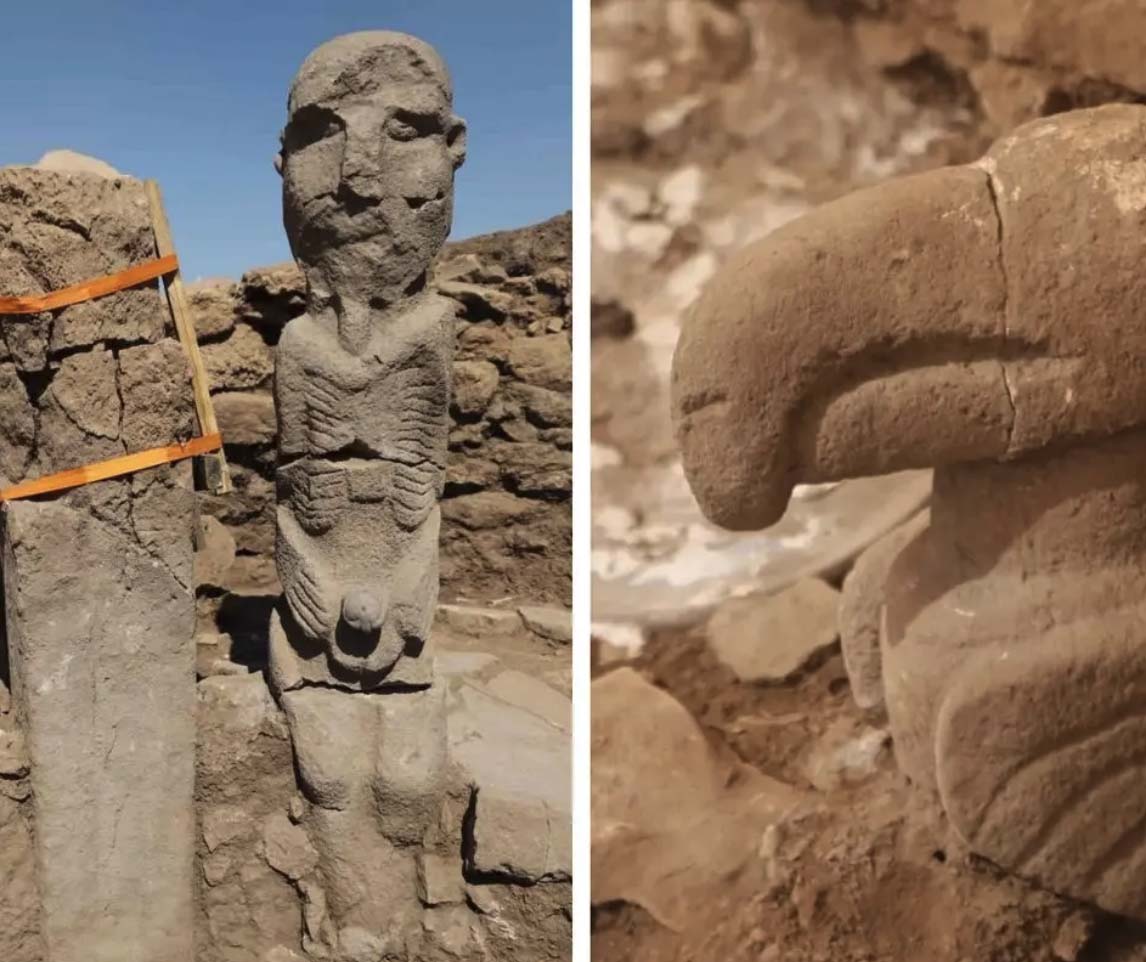
Around 40 km's from Gobekli Tepe is the site of Karahan Tepe, another ritualistic complex corresponding with the Pre-Pottery Neolithic. Karahan Tepe has similar architectural elements to the Gobekli Tepe II layer, such as 266 pillars with matching T-shaped features. One statue features a man holding his penis (creation).
11,000-Year-Old Painted Statue of Wild Boar Unearthed at Gobekli Tepe Science News - October 19, 2023

Archaeologists in Turkey have unearthed several ancient statues, including a life-size statue of a wild boar, at Gobekli Tepe, a Neolithic site known for its megalithic architecture with characteristic T-shaped pillars.
Gobekli Tepe Shamans and their Cosmic Symbols Ancient Origins - January 16, 2016
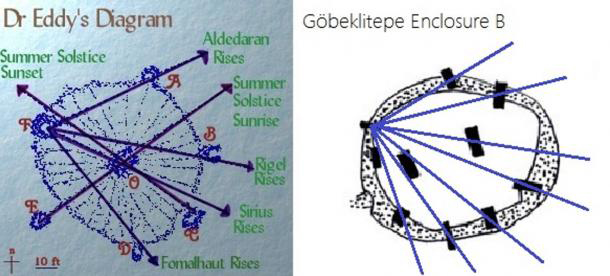
As it is understood from previous research, Gobekli Tepe was utilized as a ritual center under the control of the Neolithic shamans. Klaus Schmidt, who was the head of excavations clearly referred that Gobekli Tepe had once been the ritual center of the region. According to Schmidt, shamanic rituals were carried out in Gobekli Tepe temples, located in today's Southern Turkey. Some researchers like Andrew Collins also mention the possible shamanism in Gobekli Tepe with regard to astronomy and cosmology. He approaches the subject in terms of pole star belief which we know from shamanism. Pole star is the creation point of all the universe, according to shamans. Today in Asia, Turkish, Mongolian and Tungus shamans still believe that the sky-god Tengri Ulgen ascends the throne on the pole star, Polaris.
First Pictorial Representation of Gobekli Tepe Found Ancient Origins - September 17, 2015

A tiny bone plaque in Sanliurfa museum holds the key to the orientation of the 11,500 year-old temple complex. It was found during routine excavations at the 11,500-year-old site of Gobekli Tepe in southeast Turkey, but no one had recognized exactly what the carved lines on the small bone plaque showed. That was until Matthew Smith, a British telecommunications consultant living in Qatar, visited Sanliurfa's new archaeology museum, just 8 miles (13 kilometres) away from Gobekli Tepe itself. He saw something that everyone else had missed, and this was that the little plaque - just 6 cm by 2.5 cm in size, and no more than 3-4 mm in thickness - bore on its upper surface two T-shaped features like the T-shaped pillars found in profusion at the site. That the two T-shaped pillars shown on the plaque are side by side, their heads clearly visible, implies they signify the twin pillars found at the centre of all the major enclosures investigated so far at Gobekli Tepe. Some, like those seen in Enclosures C and D, were originally 5 to 6 metres in height and weighed as much as 15 to 20 tonnes a piece.
'World's Oldest Temple' May Have Been Cosmopolitan Center Live Science - March 16, 2012

Ancient blades made of volcanic rock that were discovered at what may be the world's oldest temple suggest that the site in Turkey was the hub of a pilgrimage that attracted a cosmopolitan group of people some 11,000 years ago. The researchers matched up about 130 of the blades, which would have been used as tools, with their source volcanoes, finding people would have come from far and wide to congregate at the ancient temple site, Gobekli Tepe, in southern Turkey. The blades are made of obsidian, a volcanic glass rich with silica, which forms when lava cools quickly. Only a tiny portion of Gobekli Tepe has been excavated so far, but what has been unearthed has been hailed by archaeologists as astounding for its great age and artistry.The site contains at least 20 stone rings, one circle built inside another, with diameters ranging from 30 to 100 feet (10 to 30 meters). The researchers suspect people would fill in the outer ring with debris before building a new circle within.
T-shaped limestone blocks line the circles, and at their center are two massive pillars about 18 feet (5.5 m) tall. Statues and reliefs of people and animals were carved on these blocks and pillars. "Some of the stones the big pillars are bigger than Stonehenge," said Tristan Carter, one of the obsidian researchers and a professor of anthropology at McMaster University in Hamilton, Canada. Even more puzzling is what has not been found. The buildings contain no hearths and the plant and animal remains there show no signs of domestication. Also, so far there have been no buildings found that archaeologists can confirm were used for everyday living. Taken together, the research indicates the site was created by hunter-gatherers, rather than farmers, who came from across a large area to build and then visit the site for religious purposes. This research is backed up by the style of some of the obsidian and stone tools which suggest that people were coming from Iraq, Iran, the Middle Euphrates and the eastern Mediterranean.